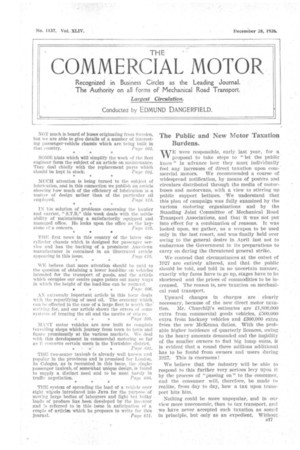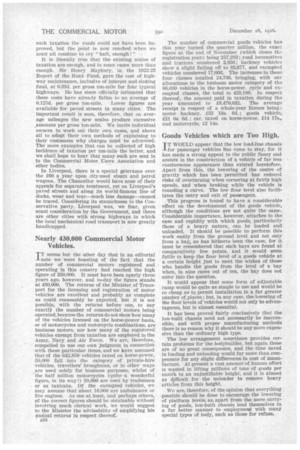The Public and New Motor Taxation Burdens.
Page 35

Page 36

If you've noticed an error in this article please click here to report it so we can fix it.
W E were responsible, early last year, for a proposal to take steps to "let the public know " inadvance how they must individually feel any increases of direct taxation upon commercial motors. We recommended a course of widespread notification, by means of posters and circulars distributed through the media of motorbuses and motorvans, with a view to stirring up public support betimes. -We understand that this plan of campaign was fully examined by the various motoring organizations and by the Standing Joint Committee of Mechanical Road Transport Associations, and that it was not put Into effect for a combination of reasons. It was looked upon, we gather, as a weapon to be used only in the last resort, and was finally held over owing to the general desire in April last not to embarrass the Government in its preparations to carry on during the threatened general strike.
We contend that circumstances at the outset of 1!)27 are entirely altered, and that the public should be told, and told in no uncertain manner, exactly why fares have to go up, stages have to be shortened and the prices of commodities to be increased. The reason is, new taxation on mechanical road transport.
Upward changes in charges are clearly necessary, because of the new direct motor taxation. • Mr. Churchill's estimates are £1,800,000 extra from commercial goods vehicles, £500,000 extra from hackney vehicles and £300000 extra from the new McKenna duties. With the probable higher incidence of quarterly licences, owing to the heavy amounts demanded and the ina,bility of the smaller owners to find big lump sums, it is evident that a round three millions additional has to be found from owners and users during 1927. This is enormous !
We believe that the Industry will be able to respond to this further very serious levy upon it by the process of "passing 'on" to the consumer, and the consumer will, therefore, be made to realize, from day to day, how a tax upon transport hits him.
.Nothing could be more unpopular, and in our view more uneconomic, than to tax transport, and we have never accepted such taxation as sound in principle, but only as an expedient. Without such taxation the roads could not have been improved, but the point is now reached when we must all combine to cry " halt, enough ! "
It is literally true that the existing scales of taxation are enough, and in some cases more than enough. Sir Henry Maybury, in the 1922-23 Report of the Road Fund, gave the cost of highway maintenance, inclusive of interest and sinking fund, at 0.33d. per gross ton-mile for four typical • highways. He has since officially intimated that these costs have already fallen to an average of 0.125d. per gross ton-mile. Lower figures are available for paved streets in many cities. The • Important result is seen, therefore, that on average mileages the new scales produce excessive Amounts per gross ton-mile. We invite individual owners to work out their own cases, and above all to adopt their own methods of explaining to their customers why charges must be advanced. The more examples that can be collected of high Incidence of taxation per ton-mile the better, and we shall hope to hear that many such are sent in to the Commercial Motor_ Users Association and other bodies.
In Liverpool, there Is a special grievance over the £60 a year upon city-used steam and petrol wagons. The Chancellor would have none of their appeals for separate treatment, yet on Liverpool's paved streets and along its world-famous line of docks, wear and tear—much less damage—cannot be traced. Considering its staunchness to the Conservative party, Liverpool was, we fear, given scant consideration by the Government, and there are other cities with strong highways in which the local mechanical road transport is now greatly handicapped.
Nearly 430,000 Commercial Motor Vehicles.
TT seems but the other day that in an editorial 1-note we were boasting of the fact that the number of commercial motors registered and operating in this country had reached the high figure of 350,000. It must have been nearly three years ago, however, and to-day the figure stands at 430,000. The returns of the Minister of Transport for the licensing and registration of motor vehicles are excellent and probably as complete as could reasonably be expected, but it is not possible, with the returns before one, to say exactly the number of commercial motors being operated, because the returns do not show how many of the vehicles licensed on the horse-power basis, or of motorcycles and motorcycle combinations, are business motors, nor how many of the registered vehicles exempt from taxation are employed in the Army, Navy and Air Force. We are, therefore, compelled to use our Own judgment in connection with these particular items, and we kave assumed that of the 642,850 vehicles taxed on horse-power, 50,000 fall into the category of private-hire vehicles, travellers' broughams, or in other ways _are used solely for business purposes, whilst of the half million motorcycles (quite a wonderful figure, in its way !) 20,000 are used by tradesmen or as taxicabs. Of the exempted vehicles, we may assume that about 16,000 are ambulances or fire engines. As one at least, and perhaps others, of the correct figures should be obtainable without involving much clerical work, we would suggest to the Minister the advisability of amplifying his annual returns in respect thereof. s18 The number of commercial goods vehicles has this year turned the quarter million, the exact figure at the end of November (which closes the registration year) being 257,283; road locomotives and tractors numbered 2,856; hackney vehicles show a slight falling off to 82,677, and exempted vehicles numbered 17,666. The increases in these four classes totalled 24,766, bringing, with our allocations to the business motor category of dal 86,000 vehicles in the horse-power, cycle and exempted classes, the total to 4243,180. In respect thereof, the amount paid in taxation during tha year amounted to £8,470,632. The average receipt in respect of a whole-year licence being: motor hackney, £33 18s. 6c1.; goods vehicle, £21 Os. 6d. ; car, taxed on horse-power, £14 17s., and motorcycle, £2 14s.
Goods Vehicles which are Too High.
TT WOULD appear that the low load-line chassis -I-for passenger vehicles has come to stay, for it has made a strong appeal to the public fancy and assists in the construction of a vehicle of far less cumbersome appearance than existed heretofore. Apart from this, the lowering of the centre of gravity which has been permitted has reduced risks of overturning when cornering at fairly high speeds, and when braking while the vehicle is rounding a curve. The low floor level also facilitates the entry and exit of passengers.
This progress is bound to have a considerable effect on the development of the goods vehicle, although the conditions are not quite the same. Considerable importance, however, attaches to the ease and rapidity with which goods, particularly those of a heavy nature, can be loaded and unloaded. It should be possible to perform this work easily from the ground level and not only from a bays as has hitherto been the case, for it must be remembered that such bays are found at comparatively few points, and it .would seem futile to keep the floor level of a goods vehicle at a certain height just to meet the wishes of those who handle the goods from the level of a bay when, in nine cases out of ten, the bay does not enter into the question.
It would appear that some form of adjustable ramp would be quite as simple to use and would be so cheap as to permit installation in a far greater number of ,places ; but, in any case, the lowering of the floor levels of vehicles would not only be advantageous, but is almost essential.
It has been proved fairly conclusively that the low-built chassis need not necessarily be inaccessible, and with proper manufacturing methods there is no reason why it should be any more expensive than the ordinary high type.
The low arrangement sometimes provides certain problems for the bodybuilder, but again these are of no great consequence, and the time saved In loading and unloading would far more than compensate for any slight differences in cost of manufacture. At present a vast amount of human effort is wasted in lifting millions of tons of goods per month to an unjustifiable height, and it Is almost as difficult for the unloader to remove heavy articles from this height.
We are, therefore, of the opinion that everything possible should be done to encourage the lowering of platform levels, as, apart from the mere carrying of goods, low-built chassis lend themselves in a far better manner to employmeat with many special types of body, such as those for refuse.




































































































